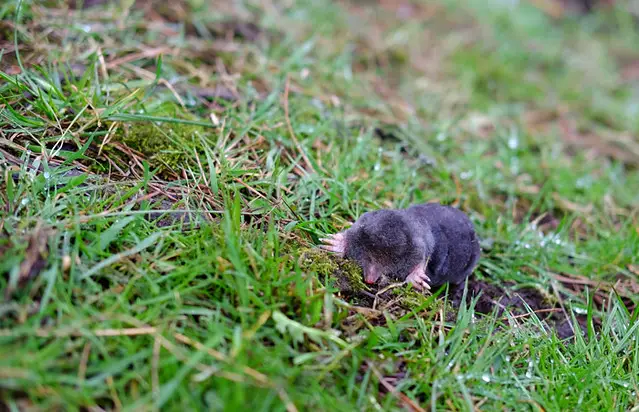Dealing with these underground pests can be frustrating, but with the power of Dawn soap, you can tackle the problem naturally and efficiently.
Follow our expert tips to safely and naturally eliminate moles from your yard for a mole-free outdoor space.
Reclaim the beauty of your lawn, and bid farewell to unsightly mole hills. Get ready to witness the remarkable results of utilizing Dawn soap in your battle against ground moles.
Let’s dive in and discover the effective solution you’ve been searching for.
Why Use Dawn Soap to Get Rid of Ground Moles?
Dawn soap is commonly used as a home remedy to deter ground moles due to its effectiveness and availability. Here are some reasons why people use Dawn soap for mole control:
- Repellent Properties: Dawn soap contains ingredients that make it unappealing to moles. When applied to the mole tunnels and molehills, the strong scent and taste of the soap can deter moles from staying in the treated areas. The soap’s texture may also disrupt their sensitive skin.
- Non-Toxic Solution: Dawn soap is generally considered safe for humans, pets, and the environment when used as directed. This makes it an appealing choice for homeowners who prefer natural or non-toxic methods of pest control.
- Easy Availability: Dawn soap is widely available in stores and online, making it convenient for homeowners to acquire and use for mole control. It is a common household item that many people already have on hand.
Steps to Use Dawn Soap to Get Rid of Ground Moles

Step 1: Gather Your Supplies
Before you begin, gather all the necessary supplies. You will need a bucket, water, a mixing container, a garden sprayer, and liquid Dawn dish soap. Make sure you have enough soap to create a concentrated solution.
Step 2: Locate Active Mole Tunnels
To effectively target the moles, you need to identify their active tunnels. Look for raised ridges or raised areas on your lawn or garden, as these indicate the presence of mole tunnels. Press down these tunnels gently and monitor them for a day or two. Active tunnels will be raised again, confirming the presence of moles.
Step 3: Mix the Dawn Soap Solution
In a mixing container, combine water with a generous amount of liquid Dawn dish soap. A good ratio is approximately 1 cup of soap for every gallon of water. Mix the solution thoroughly to ensure proper dispersion of the soap.
Step 4: Apply the Dawn Soap Solution
Fill the garden sprayer with the diluted soap solution. Now, it’s time to apply the solution to the active mole tunnels and any molehills you find. Start by spraying the solution directly into the tunnels, ensuring they are thoroughly saturated. It’s essential to apply the solution evenly and cover all the active areas. Additionally, spray the solution onto any molehills present, as moles tend to revisit these areas.
Step 5: Monitor and Repeat as Necessary
After applying the Dawn soap solution, monitor the mole activity in your yard. Check for any signs of mole activity such as new tunnels, raised ridges, or molehills. If you still notice mole activity after a few days, repeat the process. Ensure that you apply the solution to all active tunnels and molehills. Moles can be persistent, so you may need to repeat the application multiple times until the mole problem is resolved.
Alternative Methods for Mole Control:
While using Dawn soap can be a helpful approach, it may not always provide a permanent solution to a mole problem. Here are some alternative methods for mole control:
- Trapping: Mole traps are commonly used to catch and remove moles from the affected area. Traps can be placed in active tunnels and are designed to capture the mole alive. However, trapping requires some knowledge and experience to set the traps correctly.
- Natural Predators: Encouraging natural predators of moles, such as owls, hawks, or snakes, can help keep mole populations in check. Creating habitats or attracting these predators to your yard can help control mole populations naturally.
- Vibrating or Sonic Devices: Vibrating or sonic devices emit vibrations or sound waves that can irritate and discourage moles. These devices are placed in the ground and operate on batteries or solar power. However, their effectiveness can vary, and they may not work for all situations.
- Lawn Maintenance: Maintaining a healthy lawn can make it less attractive to moles. Regular mowing, proper irrigation, and reducing excessive thatch or dense vegetation can make your yard less hospitable to moles by reducing the availability of food sources.
The Damage Caused by Ground Moles:
Ground moles can cause various types of damage to lawns, gardens, and landscapes. Here are some common issues caused by ground moles:
- Molehills and Tunnels: Molehills, created by moles pushing up soil from their tunnels, can be unsightly and make mowing or walking difficult. The tunnels themselves can also damage plant roots and disturb the stability of the soil.
- Plant Damage: Moles primarily feed on earthworms, insects, and grubs. However, their tunneling activities can disrupt plant roots, leading to wilting, stunted growth, or even the death of plants.
- Uneven Surface: The extensive tunneling can create an uneven surface in the lawn or garden, making it challenging to maintain a smooth and aesthetically pleasing landscape.
- Increased Weed Growth: Mole activity can bring weed seeds to the surface, leading to an increase in weed growth in affected areas.
- Safety Hazards: Mole tunnels near the surface can create trip hazards, especially in areas with heavy foot traffic or where children play.
FAQs
Do moles come above ground?
Moles are primarily underground creatures and spend the majority of their time burrowing and tunneling. However, there are rare instances where moles may come above ground, usually during mating season or when searching for new territory. But in general, moles prefer to stay underground.
Will Dawn dish soap kill moles?
Dawn dish soap is not typically used to kill moles. Its purpose is to act as a repellent, deterring moles from staying in the treated areas. The strong scent and taste of the soap, along with its texture, can make the environment less appealing to moles. It is important to note that using Dawn soap alone may not provide a permanent solution to a mole problem and that alternative methods may be necessary for effective control.
Is Dawn soap harmful to plants or other wildlife?
When used as directed, Dawn soap is generally considered safe for plants and wildlife. However, it is always advisable to avoid directly spraying plants or applying the soap solution in excessive amounts. Rinse the foliage with water after applying the solution to minimize any potential negative effects. Additionally, while Dawn soap is safe for humans and pets, it’s important to keep pets and children away from treated areas until the soap solution has dried.
How long does it take for the Dawn soap method to work?
The effectiveness of the Dawn soap method in deterring moles can vary. Some homeowners report seeing positive results within a few days, while others may need to repeat the application multiple times before noticing a significant reduction in mole activity. It’s important to be patient and monitor the mole activity in your yard, adjusting your approach as necessary.
Can I use other types of dish soap to deter ground moles?
While Dawn dish soap is commonly used for mole control, other types of dish soap may also be effective. Look for dish soaps with similar ingredients and properties, such as strong scents or textures that moles find unappealing. It’s important to note that not all dish soaps may have the same effectiveness as Dawn, so you may need to experiment to find what works best for you.
What other methods can I use to control ground moles?
Other methods for controlling ground moles include trapping, natural predators, vibrating or sonic devices, lawn maintenance, and professional pest control. Traps can be set to catch and remove moles. Attracting natural predators like owls or hawks helps control mole populations. Vibrating or sonic devices emit deterrent vibrations or sounds. Maintaining a healthy lawn with regular mowing and reducing thatch discourages moles. For severe or persistent mole problems, professional pest control services offer effective solutions.
Conclusion
Using Dawn soap to get rid of ground moles is a popular and natural method due to its repellent properties and availability. By following the steps outlined above, you can effectively deter moles from your yard and reclaim the beauty of your lawn.
However, it’s important to note that Dawn soap may not provide a permanent solution, and alternative methods such as trapping, attracting natural predators, using vibrating or sonic devices, or maintaining a healthy lawn may be necessary for long-term mole control.
My name is Ella Vicedomine and I’m the founder of this blog. The aim is to start this informational blog to guide people on how to dispose of waste things around in the house but in the right way.

